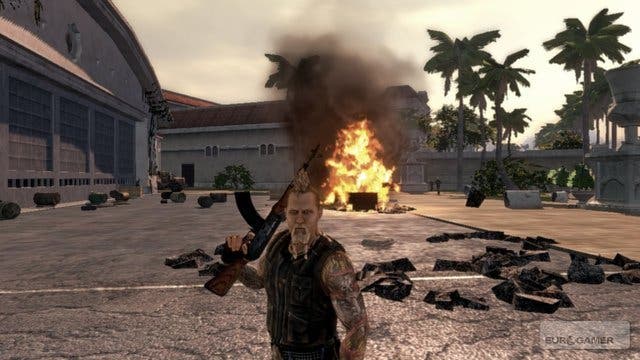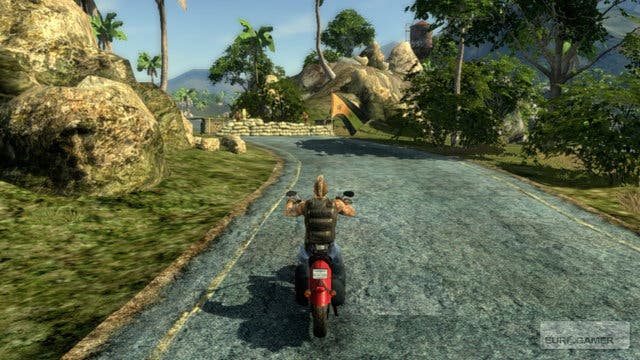Mercenaries 2: World in Flames
Down in flames.
After the occasionally inspirational chaos of the chart-topping Mercenaries: Playground of Destruction, the least anyone would reasonably expect is a more polished and entertaining sequel. Bafflingly, three and a half years on, Mercenaries 2 comes up short. Just like the original, it desperately struggles to get going, and the first few pre-sandbox missions are the worst possible introduction to what the game has to offer. But it's not just that, because - as we discovered at the preview stage - the game is irreparably hamstrung on a fundamental level.
We'd now go a little further than that: apart from some cool explosive effects and solid controls, Mercenaries 2 is utterly mediocre in almost every sense that matters. From the initial sorties onwards it's bogged down by the worst kind of brain-dead cannon fodder enemies, lead-you-by-the-hand level design, arbitrary boundaries, and some technical howlers. It lacks challenge, excitement, personality and any real verve whatsoever. Just thinking back on time spent negotiating the stupider bits of Mercenaries 2 is enough to cloud our sunny disposition.
Exactly two years in the future, the game kicks off with a playable vignette where you end up double-crossed by the hateful Ramone Solano, a man curiously obsessed with straightening his tie. Turns out it's yet another cod drama where everyone's chasing the world's rapidly depleting oil reserves, from grubby corporations to local resistance forces, except this time in Venezuela. You sit on the outskirts of all this squabbling, but with your own morally bankrupt agenda: to build a private military enterprise up, do everyone else's dirty work for big sacks of cash, and chase down the sickeningly slick Solano. As gung-ho narratives go, it's by no means the worst, but you'll very quickly cease to care about who you're mercilessly slaughtering and why. Blow stuff up. Blow it up some more. And then again to make sure.

But in spite of this - as with the 2005 original - the actual gameplay structure is well thought out, with 51 missions split between the five factions forcing you to try and keep onside with everyone. Maintaining a friendly relationship with other factions is almost essential so that you're able to traverse the map without getting into an unwelcome firefight, and, of course, so can use them as allies during specific contracts. If you end up with a hostile relationship with a faction, you'll be forced into paying an expensive bribe to be able to do any more work for them, which is a bit backward, obviously. In addition, the more contracts you get under your belt, the more hardware you can unlock. The more hardware you unlock, the more badass you end up, and the better prepared you'll be for when the game starts cranking up the challenge.
This political balancing act, and the ever-increasing tools of destruction at your disposal, are arguably Mercenaries' big point of difference in the crowded openworld genre - as it was last time out. Rather than merely hopping from one mission to the next, the need to think about the consequences of your destructive antics makes a refreshing change. Also, by giving the player three different lead characters to choose from, each with subtly different abilities (faster health recharge, faster reload, or faster movement, essentially), there's a chance to experience the game in a way that suits your preference.

Or so the theory goes. The central failing is simply that the core combat is hopelessly uninspiring. Having laid the groundwork with standard two-stick third-person controls, Pandemic steps on its own landmine by failing to provide a semblance of artificial intelligence. Enemies are, to a man, content to take up their pre-scripted positions and stand comedically until you blast them away - Driver 3-level in its obligingness. One level near the start of the game continually respawns jeeps to infinity. The design of said level itself isn't much better, presenting players with arbitrary barriers such as locked gates and shrubbery that's impervious to grenades. This, combined with the aforementioned respawning nonsense, eventually inspires desperate exploration, where, lo and behold, you discover that this supposedly fortified mansion is, in fact completely exposed around the back. This is an extreme example of level design stupidity, but it's a fairly regular occurrence.
If the game's not busy sticking its oar in, telling you exactly which enemies to take out (with laughably patronising targets above their heads, in case you weren't sure), you'll often get a blow-by-blow commentary from your cohort back at base. This can be quite useful if it means running from one gun emplacement to another to ensure enemies don't flank you. But quite often it's just completely useless advice. On one occasion you're tasked with protecting a defenceless exec while he destroys valuable data, advised to make a 'tactical retreat' up a nearby tower, but it turns out you're better off at just running around like a gun-toting Olympian during a lap of dishonour.








